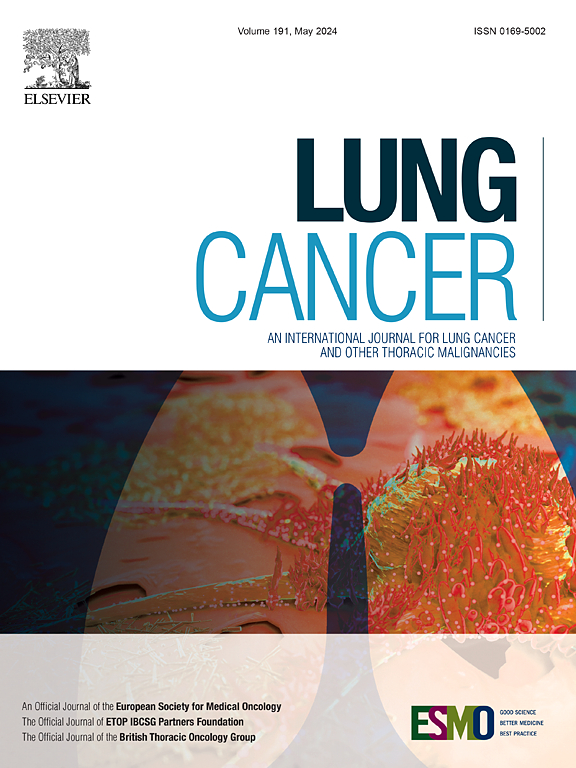Prediction recurrence in stage I epidermal growth factor receptor-mutated non-small cell lung cancer using multi-modal data
IF 4.4
2区 医学
Q1 ONCOLOGY
引用次数: 0
Abstract
Introduction
Integrated recurrence prediction models that combine clinical, imaging, and genetic data are lacking for epidermal growth factor receptor (EGFR)-mutated stage I non-small cell lung cancer (NSCLC). We developed a recurrence prediction model for Stage I EGFR-mutated NSCLC by integrating clinical, radiological, and whole-exome sequencing (WES) data.
Methods
A total of 306 patients with Stage I EGFR-mutated NSCLC were stratified into training (n = 206) and validation (n = 100) cohorts using stratified random sampling. Cox proportional hazards models combined binary labels of clinical and radiological factors from univariate analysis, machine-learning-derived MultiGenes labels (determined by multiple gene mutations) from WES data, and high-impact gene mutations. Predictive performance was assessed using the concordance index (C-index), time-dependent area under the curve (AUC), and receiver operating characteristic curves. The top three models by category were evaluated using a survival analysis.
Results
Three optimal models were identified; the clinicoradiological model (Model 17) achieved a C-index of 0.70, the model incorporating clinicoradiological factors and MultiGenes (Model 28) achieved 0.69, and the clinicoradiological model with TP53 mutations (Model 39) demonstrated the best performance, with 0.73. In Model 17, the 60-month recurrence-free survival (RFS) rates were 59.1 % for the high-risk group and 83.2 % for the low-risk group (hazard ratio [HR] = 3.47; 95 % confidence interval [CI]: 1.60–8.00). Model 39, which incorporated TP53 mutations, demonstrated superior performance, with 60-month RFS rates of 57.1 % for the high-risk and 87.1 % for the low-risk groups (HR = 4.79; 95 %CI: 1.96–11.69).
Conclusions
Clinical and radiological factors are effective predictors of recurrence risk in Stage I EGFR-mutated NSCLC, and incorporating TP53 mutation data further improves the prognostic accuracy.

使用多模式数据预测I期表皮生长因子受体突变的非小细胞肺癌复发
对于表皮生长因子受体(EGFR)突变的I期非小细胞肺癌(NSCLC),缺乏结合临床、影像学和遗传数据的综合复发预测模型。我们通过整合临床、放射学和全外显子组测序(WES)数据,建立了一期egfr突变NSCLC的复发预测模型。方法采用分层随机抽样方法,将306例I期egfr突变NSCLC患者分为训练组(n = 206)和验证组(n = 100)。Cox比例风险模型结合了来自单变量分析的临床和放射因素的二元标签、来自WES数据的机器学习衍生的MultiGenes标签(由多个基因突变决定)和高影响基因突变。使用一致性指数(C-index)、随时间变化的曲线下面积(AUC)和受试者工作特征曲线评估预测性能。使用生存分析对分类前三名的模型进行评估。结果确定了3种最优模型;临床放射学模型(模型17)的c指数为0.70,结合临床放射学因素和MultiGenes的模型(模型28)的c指数为0.69,TP53突变的临床放射学模型(模型39)的c指数为0.73,表现最好。在模型17中,高风险组60个月无复发生存率(RFS)为59.1%,低风险组为83.2%(风险比[HR] = 3.47; 95%可信区间[CI]: 1.60-8.00)。纳入TP53突变的模型39表现出更好的表现,高风险组的60个月RFS率为57.1%,低风险组为87.1% (HR = 4.79; 95% CI: 1.96-11.69)。结论临床和放射学因素是egfr突变的I期非小细胞肺癌复发风险的有效预测因素,结合TP53突变数据可进一步提高预后的准确性。
本文章由计算机程序翻译,如有差异,请以英文原文为准。
求助全文
约1分钟内获得全文
求助全文
来源期刊

Lung Cancer
医学-呼吸系统
CiteScore
9.40
自引率
3.80%
发文量
407
审稿时长
25 days
期刊介绍:
Lung Cancer is an international publication covering the clinical, translational and basic science of malignancies of the lung and chest region.Original research articles, early reports, review articles, editorials and correspondence covering the prevention, epidemiology and etiology, basic biology, pathology, clinical assessment, surgery, chemotherapy, radiotherapy, combined treatment modalities, other treatment modalities and outcomes of lung cancer are welcome.
 求助内容:
求助内容: 应助结果提醒方式:
应助结果提醒方式:


